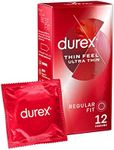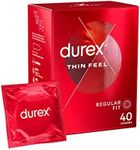Buying Guide for the Best Thinnest Condoms
When choosing the thinnest condoms, the primary goal is to enhance sensitivity and intimacy while ensuring safety and reliability. Thinner condoms can provide a more natural feel, which many users find desirable. However, it's crucial to balance thinness with strength to ensure protection. Understanding the key specifications will help you make an informed decision that aligns with your needs and preferences.MaterialThe material of a condom is crucial as it affects both the thinness and the sensation. Common materials include latex, polyurethane, and polyisoprene. Latex is widely used and offers good elasticity and strength, but some people may have allergies. Polyurethane is thinner and can transmit heat better, enhancing sensation, but it is less elastic. Polyisoprene is a good alternative for those with latex allergies, offering a similar feel to latex. Choose a material based on your sensitivity to latex and your preference for sensation.
ThicknessThickness is a key factor in determining how much sensation is felt during use. Thinner condoms, often labeled as 'ultra-thin' or 'sensitive,' can enhance the feeling of closeness. Thickness is usually measured in microns, with thinner condoms being around 50 microns or less. If you prioritize sensation and a natural feel, opt for the thinnest available that still meets safety standards. However, ensure that the thinness does not compromise the condom's strength and reliability.
SizeSize is important for comfort and effectiveness. Condoms that are too tight can break, while those that are too loose can slip off. Sizes typically range from snug to large, with standard sizes fitting most users. Measure your size to ensure a proper fit, which will enhance comfort and safety. If you are unsure, start with a standard size and adjust based on your experience.
LubricationLubrication can affect the feel and performance of a condom. Most condoms come pre-lubricated to reduce friction and enhance pleasure. Some are coated with silicone-based lubricants, which last longer, while others use water-based lubricants, which are easier to clean. If you or your partner have sensitive skin, look for condoms with hypoallergenic lubricants. Consider additional lubrication if needed, but ensure it is compatible with the condom material.
Brand ReputationThe reputation of the brand can be an indicator of quality and reliability. Established brands often conduct rigorous testing to ensure their products meet safety standards. Look for brands that are well-reviewed and have a history of producing reliable products. While trying new brands can be tempting, sticking with reputable ones can provide peace of mind regarding safety and effectiveness.
















